|
|
The most common cause of work-related discomfort and injury is working in the same position for long periods of time...like when working on a computer. This stationary positioning requires your muscles to work under constant strain, which reduces blood flow and oxygen to hard-working tissues.
By alternating the types of tasks you perform throughout the day and taking more frequent breaks (at least 1 minute/hour), you can significantly reduce your overall fatigue and the risk of Cumulative Trauma Disorder.
|
 |
 |
| Work Habits and Task Rotation Tips |
 |
- Stand up while talking on the phone.
- Alternate between mouse intensive and keyboard intensive work.
- If you have a large number of e-mails to return, answer them in subsets throughout the day.
- If appropriate, communicate messages/information to nearby employees in person.
- Perform short stretches at least one minute every hour. Use RSIGuard to remind you!
|
 |
 |
 |
| Micro-break Stretches |
- No pain should be felt during the stretch.
If any stretch hurts, reduce
the intensity or do not do the stretch at all.
- Check with your doctor before stretching
if you have an injury or discomfort in the part of your body you're stretching.
- Hold each stretch for 5-10 seconds.
- Stretch at least a few minutes every hour.
|

|
Shoulder Shrugs
(help reduce upper back and neck discomfort)
|
| |
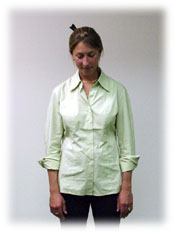

|
STEP 1) Stand or sit straight up; arms relaxed by your side
STEP 2) Slowly roll shoulders straight up towards your ears
STEP 3) Then squeeze shoulders together, and let them roll down and back; movement should be smooth and circular, and should take 3-5 seconds; a mild, comfortable stretch should be felt through your shoulders and lower neck
STEP 4) Repeat 5 times
|

|
Neck Stretch
(helps reduce upper back and neck discomfort)
|
| |

|
STEP 1) Put left arm behind your back
STEP 2) Slowly bend your right ear toward your right shoulder; a mild, comfortable stretch should be felt through neck and upper shoulder
STEP 3) Hold 10 seconds, release slowly
STEP 4) Switch sides
|
|

|
Mid-Back Stretch
(helps reduce fatigue between shoulder blades)
|
| |
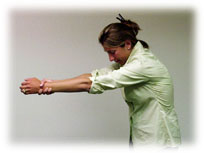
|
STEP 1) Reach both arms straight out in front of you (standing or sitting)
STEP 2) Grab your left wrist lightly and pull left arm an inch further out
STEP 3) Inhale deeply and hold for 5 seconds; a mild, comfortable stretch should be felt in your mid back, between your shoulders
STEP 4) Hold stretch for 5 seconds, exhale and release slowly, switch sides
|

|
Chest Stretch
(helps increase circulation to the arms and hands)
|
| |

|
STEP 1) Place a relaxed slightly bent arm on a stationary object (your hand should be directly to your side and below your shoulder)
STEP 2) Slowly rotate your body away from your hand; a mild, comfortable stretch should be felt through your chest and shoulder
STEP 3) Hold stretch 10 seconds, release slowly
STEP 4) Switch sides
|

|
Wrist Extensor Stretch
(helps reduce forearm and wrist fatigue)
|
| |
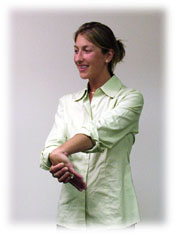
|
STEP 1) Straighten your right arm out in front of you
STEP 2) Point your fingers towards floor
STEP 3) Use your left hand to mildly stretch the right wrist further; slowly rotate right fingers to point away from your body; a mild comfortable stretch should be felt through the top of your forearm
STEP 4) Hold 10 seconds
STEP 5) Switch sides
|

|
Wrist Flexor Stretch
(helps reduce forearm and wrist fatigue)
|
| |
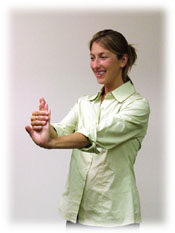
|
STEP 1) Straighten your left arm out in front of you
STEP 2) Bend your wrist backwards, point your fingers up
STEP 3) Use your right hand to mildly stretch the bending wrist further; a mild, comfortable stretch should be felt through the bottom of your forearm
STEP 4) Hold 10 seconds
STEP 5) Switch sides
|
|

|
Prayer Stretch
(helps reduce hand and forearm fatigue)
|
| |
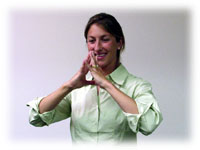
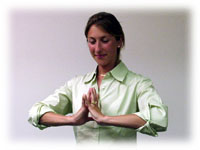
|
STEP 1) Place your fingertips together in a prayer position (no other part of your hand should touch)
STEP 2) Slowly move hands down from eye level to chest level; slowly rotate fingers to point towards your chest; a mild, comfortable stretch should be felt through your fingers, hands and wrist
STEP 3) Hold stretch for 10 seconds, release slowly
STEP 4) Repeat 2 to 3 times
|

|
Hamstring Stretch
(helps reduce lower back discomfort)
|
| |
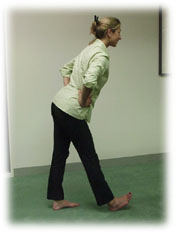
|
STEP 1) Standing, put your left leg straight out in front of you (can be performed with your heel on 2-6" step or flat on ground)
STEP 2) Lift your left toes up so only your heel touches the ground or step
STEP 3) Keeping your back as straight as possible, bend forward from your hip; a mild, comfortable stretch should be felt at the back of your thigh
STEP 4) Hold stretch for 10 seconds, release slowly
STEP 5) Switch sides
|

|
Standing Back Bend
(helps reduce lower back discomfort)
|
| |
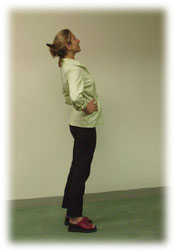
|
STEP 1) Place your hands on your hips and your feet shoulder width apart; slowly lean backwards
STEP 2) Look up towards the roof, hold for 10 seconds; a mild, comfortable stretch should be felt through your low and mid-back
STEP 3) Hold stretch for 10 seconds, release slowly
|













